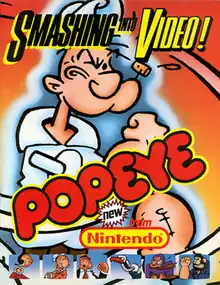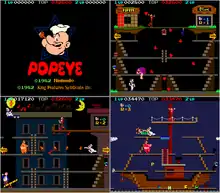Popeye (video game)
Popeye[lower-alpha 1] is a 1982 platform game developed and released by Nintendo as an arcade video game. It is based on the comic strip of the same name created by E. C. Segar and licensed from King Features Syndicate. Some sources claim that Ikegami Tsushinki did programming work on the game.[7][8][9] As Popeye, the player must collect hearts thrown by Olive Oyl from the top of the screen while being chased by Brutus. Popeye can punch bottles thrown at him, but can only hurt Brutus after eating the one can of spinach present in each level. Unlike Nintendo's earlier Donkey Kong games, there is no jump button. There are three screens.
| Popeye | |
|---|---|
 North American arcade flyer | |
| Developer(s) | |
| Publisher(s) | Nintendo (arcade, NES) Atari, Inc. (arcade EU/UK)[2] Parker Brothers |
| Designer(s) | Genyo Takeda[3] Shigeru Miyamoto[3] |
| Platform(s) | Arcade, Atari 2600, Atari 5200, Atari 8-bit, ColecoVision, Commodore 64, Intellivision, Odyssey², NES, TI-99/4A |
| Release | |
| Genre(s) | Platform |
| Mode(s) | 1-2 players alternating turns |
The game was licensed by Atari, Inc. for exclusive release in the United Kingdom and Ireland in an Atari-designed cabinet. Nintendo ported the game to the Famicom, and Parker Brothers published versions for other home systems. Popeye no Eigo Asobi is an English teaching spin-off released for the Famicom on November 22, 1983.
Gameplay

The object of the game is for Popeye the Sailor to collect a certain number of items dropped by Olive Oyl, depending on the level—24 hearts, 16 musical notes, or 24 letters in the word "HELP"—while avoiding the Sea Hag, Brutus, and other dangers. The player can make Popeye walk back and forth and up and down stairs and ladders with a 4-way joystick. There is a punch button, but unlike similar games of the period, no jump button.
Brutus chases Popeye and can jump down a level, reach down to the next lower level, and jump up to hit Popeye if he is directly above. Popeye can attack Brutus after eating the can of spinach found in each level. Spinach makes Popeye invincible for a short period, during which Brutus runs away and can be temporarily knocked out simply by running into him.
Popeye punches to destroy harmful items such as bottles, vultures, and skulls. Popeye loses a life when hit by Brutus or any flying object, or if he fails to collect a dropped item within a certain time after it reaches the bottom of the screen. Popeye can occasionally use a punching bag to knock loose a barrel. If the barrel falls onto Brutus's head, the player earns bonus points and renders Brutus harmless for several seconds.
Other licensed Popeye characters in the game are Olive Oyl, Swee'Pea, and Wimpy.
Development
Popeye was designed by Genyo Takeda and Shigeru Miyamoto. Previously, Nintendo had originally intended to make a video game based on the Popeye characters, but was denied a license, so the mostly original characters of Mario, Donkey Kong, and Pauline were developed for Donkey Kong (1981).[10]
Ports
Parker Brothers ported the game to the Atari 8-bit family, Atari 2600, Atari 5200, Intellivision, Commodore 64, TI-99/4A, and ColecoVision, and is one of the few games ported to the Magnavox Odyssey².
On July 15, 1983, Popeye became one of the three launch games for the Famicom, along with Donkey Kong and Donkey Kong Jr..[11]
Reception
In the United States, Popeye topped the Play Meter arcade chart for street locations in April 1983.[12]
Electronic Games wrote in 1983 that the arcade version of Popeye at first appeared to be "yet another variation of a theme that's become all too familiar since Donkey Kong [...] But there are some nuances, not the least of which are the graphics and sound effects, that tend to allow the game the benefit of the doubt in execution. [...] Popeye does offer some interesting play that is more than complemented by the cosmetics."[13] The Arcade Express newsletter scored it 7 out of 10 in January 1983, calling it "the closest thing to a videogame cartoon seen yet in an arcade", but also that "game play, unfortunately, doesn't come up to visual standards."[14] Michael Pugliese writing for The Coin Slot described Popeye as "a visually stimulating and exciting game that will go well in any location [...] it contains all the challenges and character appeal to make it a solid earner for a long time."[15] Computer and Video Games magazine gave the arcade game a generally favorable review.[16]
Antic wrote that the Atari 8-bit version "is a thoroughly entertaining challenge for gamers of all ages" and that its mechanics unique among climbing games gave it above-average replay value.[17] Computer Games magazine gave the ColecoVision and home computer conversions an A rating, calling Popeye a "terrific cartoony climbing game, much better than Donkey Kong".[18]
Legacy
Popeye no Eigo Asobi is an English teaching spin-off for Famicom, released on November 22, 1983. A board game based on the video game was released by Parker Brothers in 1983.
In 2008, Namco Networks released an enhanced remake for mobile phones. The gameplay is largely the same, plus an enhanced mode with a bonus stage and an extra level that pays homage to the short A Dream Walking where Popeye must save Olive from sleepwalking. Tokens are earned to buy old comic strips.[19]
On November 4, 2021, Popeye was released for Nintendo Switch as a 3D reimagining of the arcade game.[20] It was met with poor Metacritic scores.
Ben Falls earned the world record score of 3,023,060 on December 20, 2011, according to the Twin Galaxies International Scoreboard.[21]
References
- McFerran, Damien (February 26, 2018). "Feature: Shining A Light On Ikegami Tsushinki, The Company That Developed Donkey Kong". Nintendo Life. Retrieved June 9, 2020.
- "Official European Flyer".
- "Iwata Asks: Punch-Out!! - Investigating a Glove Interface". Nintendo. August 7, 2009. Retrieved August 11, 2009.
- "Popeye. (Registration Number PA0000154248)". United States Copyright Office. Retrieved June 6, 2021.
- Akagi, Masumi (October 13, 2006). アーケードTVゲームリスト国内•海外編(1971-2005) [Arcade TV Game List: Domestic • Overseas Edition (1971-2005)] (in Japanese). Japan: Amusement News Agency. pp. 57, 128. ISBN 978-4990251215.
- "Video Game Flyers: Popeye, Nintendo (EU)". The Arcade Flyer Archive. Retrieved April 25, 2021.
- "Company:Ikegami Tsushinki - GDRI :: Game Developer Research Institute". gdri.smspower.org.
- ドンキーコング裁判についてちょこっと考えてみる Archived March 12, 2010, at the Wayback Machine Thinking a bit about Donkey Kong, accessed February 1, 2009
- It started from Pong (それは『ポン』から始まった : アーケードTVゲームの成り立ち, sore wa pon kara hajimatta: ākēdo terebi gēmu no naritachi), Masumi Akagi (赤木真澄, Akagi Masumi), Amusement Tsūshinsha (アミューズメント通信社, Amyūzumento Tsūshinsha), 2005, ISBN 4-9902512-0-2.
- East, Tom (November 25, 2009). "Donkey Kong Was Originally A Popeye Game". Official Nintendo Magazine. Archived from the original on November 10, 2014. Retrieved November 6, 2014.
Miyamoto says Nintendo's main monkey might not have existed.
- Marley, Scott (December 2016). "SG-1000". Retro Gamer. No. 163. Future Publishing. pp. 56–61.
- "Play Meter's Equipment Poll: Top Videos". Play Meter. Vol. 9, no. 8. May 1, 1983. p. 16.
- Sharpe, Roger C. (June 1983). "Insert Coin Here". Electronic Games. p. 92. Retrieved January 6, 2015.
- "The Hotseat: Popeye" (PDF). The Arcade Express. Vol. 1, no. 11. January 2, 1983.
- Pugliese, Michael (April 1983). "Games in Review: The Arcade Parade". The Coin Slot. p. 14. Retrieved October 17, 2017.
- "Arcade Action: Packing a Punch! Popeye". Computer and Video Games. No. 19 (May 1983). April 16, 1983. p. 31.
- Duberman, David (January 1984). "Popeye". Antic. p. 107.
- "1985 Software Buyer's Guide". Computer Games. Vol. 3, no. 5. United States: Carnegie Publications. February 1985. pp. 11–8, 51–8.
- Popeye at IGN
- "Popeye". Nintendo.com. Sabec LTD. November 2021.
- Totilo, Stephen (December 20, 2011). "The new Popeye World Record is 3,023,060". Kotaku. Archived from the original on November 12, 2014.
External links
![]() Media related to Popeye (video game) at Wikimedia Commons
Media related to Popeye (video game) at Wikimedia Commons
- Popeye at the Killer List of Videogames
- Popeye at NinDB
- The Atari 2600 version of Popeye can be played for free in the browser at the Internet Archive
- Popeye (1982) at MobyGames